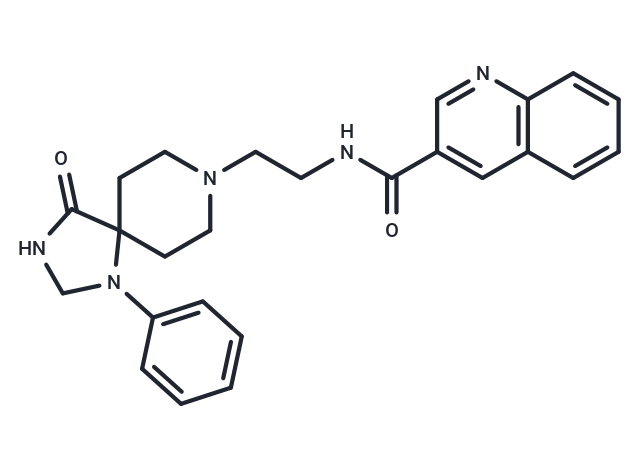Shopping Cart
- Remove All
 Your shopping cart is currently empty
Your shopping cart is currently empty

VU0285655-1(BML-280) is a potent and selective phospholipase D2 (PLD2) inhibitor that inhibits the proliferation of PLD2-deficient cells.VU0285655-1 has an inhibitory effect on high glucose-induced caspase-3 cleavage and reduction of cell viability.VU0285655-1 is used in the study of diabetic retinopathy.

| Pack Size | Price | Availability | Quantity |
|---|---|---|---|
| 1 mg | $78 | In Stock | |
| 5 mg | $189 | In Stock | |
| 10 mg | $313 | In Stock | |
| 25 mg | $653 | In Stock | |
| 50 mg | $916 | In Stock | |
| 100 mg | $1,230 | In Stock |
| Description | VU0285655-1(BML-280) is a potent and selective phospholipase D2 (PLD2) inhibitor that inhibits the proliferation of PLD2-deficient cells.VU0285655-1 has an inhibitory effect on high glucose-induced caspase-3 cleavage and reduction of cell viability.VU0285655-1 is used in the study of diabetic retinopathy. |
| In vitro | VU0285655-1 (BML-280) (0-5 µM; 24 h; Wild-type, PLD1- and PLD2-deficient astrocytes) reduces proliferation in PLD1-deficient cells, but also in PLD2-deficient cells exposed to IGF-1. BML-280 had minor effects in wild-type and PLD2-deficient cells but completely blocked PLD activity in PLD1-deficient cells. Caused a highly significant inhibition of glial proliferation when astrocytes were stimulated by FCS (fetal calf serum) or IGF-1, respectively. Showed non-specific effects because they inhibited cell proliferation even in PLD1/2 double knockouts at 5 µM.[1] BML-280 inhibits mRNA levels and secretion of tumor necrosis factor-α, IL-1β and IL-8 in human periodontal ligament cells.[2] VU0285655-1 shows an approximately 21-fold selectivity for PLD2.[3] BML-280 (0-0.1 µM) suppresses formyl-Met-Leu-Phe (fMLP)-stimulated PLD activity in a concentration-dependent manner, with an IC50 of 0.04 ± 0.01 μM.[3] BML-280 (0-0.3 µM) inhibits O2- generation, and the inhibition reaches a plateau (about 20 % inhibition) at around 0.01 μM to 0.3 μM.[3] |
| Alias | VU-0285655, VU 0285655, BML-280, BML280, BML 280 |
| Molecular Weight | 429.51 |
| Formula | C25H27N5O2 |
| Cas No. | 1158347-73-9 |
| Smiles | O=C1C2(N(CN1)C3=CC=CC=C3)CCN(CCNC(=O)C4=CC5=C(N=C4)C=CC=C5)CC2 |
| Relative Density. | 1.32 g/cm3 (Predicted) |
| Storage | store at low temperature | Powder: -20°C for 3 years | In solvent: -80°C for 1 year | Shipping with blue ice. | |||||||||||||||||||||||||||||||||||
| Solubility Information | DMSO: 50 mg/mL (116.41 mM), Sonication is recommended. | |||||||||||||||||||||||||||||||||||
Solution Preparation Table | ||||||||||||||||||||||||||||||||||||
DMSO
| ||||||||||||||||||||||||||||||||||||

Copyright © 2015-2025 TargetMol Chemicals Inc. All Rights Reserved.